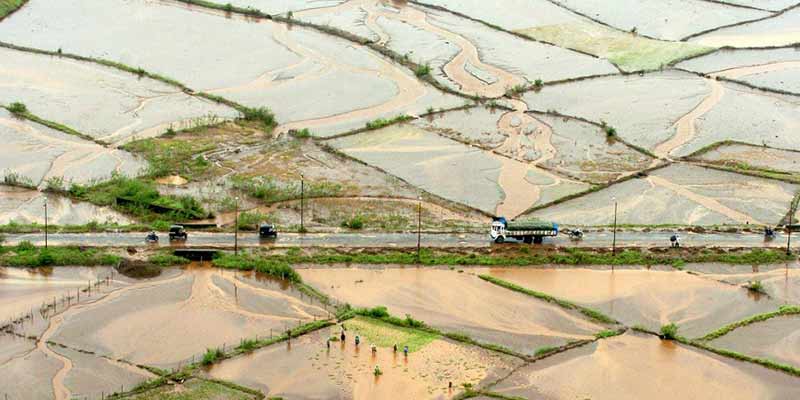- India
- Mar 12
- Sreesha V.M
What is soil fertility mapping?
Soil & Land Use Survey of India (SLUSI), under Department of Agriculture & Farmers’ Welfare, is generating district/village-wise digital soil fertility maps through geo-spatial techniques using Soil Health Card (SHC) data.
Benefits of Soil fertility maps:
• Soil fertility maps provide detailed spatial information about the nutrient composition and health of the soil.
• It helps farmers in application of fertilizers and soil amendments judiciously, reducing the risk of overuse or underuse.
• It enhances economic outcomes for farmers, as they are able to maximise their returns with less input, thus increasing overall profitability.
• Geospatial techniques, including remote sensing & AI based tools, are used in soil fertility mapping.
• The Soil Health Card sampling point is geo-coded using GPS. The sample is assigned a unique QR Code, and this QR code is retained during analysis in soil testing labs.
• Soil fertility data in the form of SHCs is made available to farmers.
• Challenges like logistical, technical, and physical infrastructure barriers are there in remote and hilly areas for soil fertility mapping.
• Currently, use of village-level soil testing labs and mini labs in hilly and remote areas are addressing these challenges.
• Soil degradation and nutrient deficiencies have been identified through comprehensive mapping efforts using soil survey and SHC data.
• Soil fertility mapping is an essential tool which provides precise, location specific data on the nutrient and soil health status.
• It enables farmers to identify areas with nutrient deficiencies or surpluses, allowing for targeted fertilizer application customised to the specific needs.
• Mapping the availability of nutrients in the soil, farmers can avoid the indiscriminate use of fertilizers, ensuring appropriate usage.
• The scheme is available to all states & UTs.
Soil Health Cards
• Soil health is fundamental to the food system in the country. It forms the bedrock of agriculture and serves as the vital medium for the growth of food-producing plants. When soils are healthy, they yield higher productivity of nutritious crops that provide nourishment for both humans and animals.
• It is important to recognise that the quality and quantity of our food are directly connected to the quality of our soils. Therefore, prioritising soil health is essential for ensuring the availability of high-quality and abundant food for all and reducing dependency on other countries for agricultural produce.
• Soil Health Cards (SHCs) scheme was introduced in 2014-15. It is a programme for soil sampling, testing and generation of SHCs which was launched to assist state governments to issue soil health cards to all farmers in the country.
• The aim of the scheme is to assist states/Union Territories to provide Soil Health Cards for all farm holdings to promote balanced and integrated nutrient management as per the recommendations of Indian Council of Agricultural Research (lCAR) to prevent the deterioration of soil quality.
• This initiative is a part of the broader government effort to improve agricultural sustainability, optimise resource use, and enhance farmers’ income across the country.
• Under the scheme, Soil Health Cards are issued to farmers that provide information on nutrient status of soil and recommendations on judicious dosage and type of fertilisers for improving soil health and its fertility.
• Once the Soil Health Card is generated, the advisory/guidelines are given to farmers through Agricultural Technology Management Agency (ATMA), Krishi Vigyan Kendra (KVK), Krishi Sakhi, etc.
• Soil samples are processed through standard procedures and analysed for parameters such as pH, electrical conductivity, organic carbon, available nitrogen, phosphorus, potassium, sulphur, and micro-nutrients (zinc, copper, iron, manganese & boron).
• Soil Health Card scheme has been merged in Rashtriya Krishi Vikas Yojana (RKVY) as its one component under name ‘Soil Health & Fertility’ from the year 2022-23.
• The government made some technological interventions in the New Soil Health Card Scheme. The Soil Health Card portal has been revamped and integrated with a Geographic Information System (GIS) system so that all the test results are captured and seen on a map.
• To make the implementation/monitoring of the scheme smooth and to facilitate farmers an easy access to his soil health card, the mobile application has been made robust with many additional features.
• Under the scheme, there is also provision to set up static Soil Testing Labs (STLs), Mobile Soil Testing Labs, Mini Soil Testing Labs and Village Soil Testing Labs besides strengthening of existing laboratories to undertake soil testing.
• Till date, 8,272 soil testing labs (1,068 static soil testing labs, 163 mobile soil testing labs, 6,376 mini soil testing labs and 665 village level soil testing labs) have been established across the country.
(The author is a trainer for Civil Services aspirants.)

